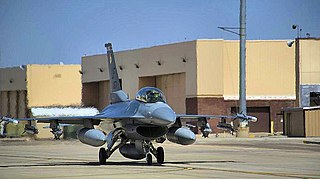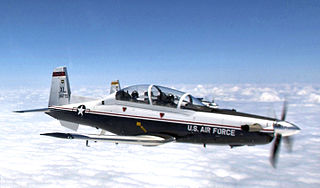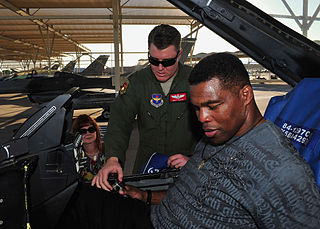
Luke Air Force Base is a United States Air Force base in Maricopa County, Arizona, United States. It is located 7 miles west of the central business district of Glendale, and 15 miles west of Phoenix.

The 65th Aggressor Squadron is a United States Air Force unit currently operating the F-35A Lightning II. It is assigned to the 57th Operations Group at Nellis Air Force Base, Nevada.

The 61st Fighter Squadron is an active United States Air Force unit, assigned to the 56th Operations Group, at Luke Air Force Base, Arizona. It operates the F-35 Lightning II aircraft, conducting Pilot training.

The 62d Fighter Squadron is part of the United States Air Force 56th Operations Group at Luke Air Force Base, Arizona. It operates the Lockheed Martin F-35A Lightning II aircraft conducting advanced fighter training.

The 69th Fighter Squadron is a United States Air Force Reserve fighter squadron. It is assigned to the 944th Operations Group, stationed at Luke Air Force Base, Arizona.

The 309th Fighter Squadron is part of the 56th Operations Group at Luke Air Force Base, Arizona. It operates the F-16 Fighting Falcon aircraft conducting advanced fighter training.

The 310th Fighter Squadron is part of the 56th Operations Group at Luke Air Force Base, Arizona. It operates the Lockheed Martin F-35A Lightning II, conducting advanced fighter training.

The 311th Fighter Squadron (Sidewinders) is part of the 54th Fighter Group at Holloman Air Force Base, New Mexico which is a geographically separated unit under the 56th Fighter Wing at Luke Air Force Base, Arizona. It operates the General Dynamics F-16 Fighting Falcon aircraft conducting advanced fighter training. The squadron previously operated the Fighting Falcon conducting advanced fighter training at Luke and was inactivated due to budget constraints after the end of the Cold War. It was recently reactivated at Holloman and the aircraft were received from the 309th Fighter Squadron.

The 418th Test and Evaluation Squadron is an active United States Air Force unit assigned to the 53rd Test and Evaluation Group, and stationed at Davis-Monthan Air Force Base, Arizona, where it was activated on 1 October 2021.

The 84th Flying Training Squadron was part of the United States Air Force 47th Flying Training Wing based at Laughlin Air Force Base, Texas. It operated Beechcraft T-6 Texan II aircraft conducting flight training.

The 550th Fighter Squadron is an active United States Air Force unit. Its current assignment is with 56th Operations Group, at Kingsley Field, Oregon.

The 431st Test and Evaluation Squadron is an inactive United States Air Force unit. Its last assignment was with the Tactical Air Command 57th Fighter Wing stationed at Nellis Air Force Base, Nevada. It was inactivated on 30 June 1992.

The 46th Fighter Training Squadron is an inactive United States Air Force unit. Its last assignment was with the 917th Operations Group at Barksdale Air Force Base, Louisiana. where it was inactivated on 1 October 1993.

The 56th Operations Group is a unit of the United States Air Force, and the flying component of the 56th Fighter Wing.

The 433rd Weapons Squadron is a United States Air Force unit, assigned to the USAF Weapons School at Nellis AFB, Nevada.

The 461st Flight Test Squadron is a United States Air Force squadron, assigned to the 412th Operations Group of Air Force Materiel Command, and is stationed at Edwards Air Force Base, California. The Squadron performs flight testing on the Lockheed Martin F-35 Lightning II.

The 56th Training Squadron is an active United States Air Force unit. It is assigned to the 56th Operations Group at Luke Air Force Base, Arizona.

The 33d Operations Group is the flying component of the 33d Fighter Wing, assigned to Air Education and Training Command of the United States Air Force. The group is stationed at Eglin Air Force Base, Florida.

The 325th Operations Group is the flying component of the 325th Fighter Wing, assigned to Air Combat Command of the United States Air Force. The group is stationed at Tyndall Air Force Base, Florida. It conducts training on the Lockheed Martin F-22 Raptor and commands one operational Raptor squadron. It directs the flying and support operations of two F-22 squadrons, a fighter training squadron, an operations support squadron and a training support squadron.

The 56th Fighter Wing is a fighter wing in the United States Air Force. It is the world's largest Lockheed Martin F-35 Lightning II wing and one of two Air Force F-35 training locations. Additionally, it is one of two active-duty F-16 training bases. The 56th graduates dozens of F-35 and General Dynamics F-16 Fighting Falcon pilots and 300 air control professionals annually.


 (modified 2 March 1995)
(modified 2 March 1995)



























